Computational Design: Technology, Cognition and Environments
By: and and
Sign Up Now!
Already a Member? Log In
You must be logged into Bookshare to access this title.
Learn about membership options,
or view our freely available titles.
- Synopsis
- New computational design tools have evolved rapidly and been increasingly applied in the field of design in recent years, complimenting and even replacing the traditional design media and approaches. Design as both the process and product are changing due to the emergence and adoption of these new technologies. Understanding and assessing the impact of these new computational design environments on design and designers is important for advancing design in the contemporary context. Do these new computational environments support or hinder design creativity? How do those tools facilitate designers’ thinking? Such knowledge is also important for the future development of design technologies. Research shows that design is never a mysterious non-understandable process, for example, one general view is that design process shares a common analysis-synthesis-evaluation model, during which designers interact between design problem and solution spaces. Understanding designers’ thinking in different environments is the key to design research, education and practice. This book focuses on emerging computational design environments, whose impact on design and designers have not been comprehensively and systematically studied. It comprises three parts. The history and recent developments of computational design technologies are introduced in Part I. The main categories of technologies cover from computer-aided drafting and modelling tools, to visual programming and scripting tools for algorithmic design, to advanced interfaces and platforms for interactions between designers, between designers and computers, and between the virtual environment and the physical reality. To critically explore design thinking, especially in these new computational design environments, formal approaches to studying design thinking and design cognition are introduced and compared in Part II, drawing on literature and studies from the 70s to the current era. Part III concludes the book by exploring the impact of different computational design technologies on design and designers, using a series of case studies conducted by the author team building on their close collaboration over the past five years. The book offers new insights into designers’ thinking in the rapidly evolving computational design environments, which have not been critically and systematically studied and reported in the current literature. The book is meant for design researchers, educators and students, professional practitioners and consultants, as well as people who are interested in computational design in general.
- Copyright:
- 2022
Book Details
- Book Quality:
- Publisher Quality
- Book Size:
- 242 Pages
- ISBN-13:
- 9780429536373
- Related ISBNs:
- 9780429260780, 9780367774936, 9780429522901, 9780429551079, 9780367203061
- Publisher:
- CRC Press
- Date of Addition:
- 04/09/24
- Copyrighted By:
- Taylor & Francis Group, LLC. Reasonable efforts have been made to publish reliable data and information, but the author and publisher cannot assume responsibility for the validity of all materials or the consequences of their use. The authors and publisher
- Adult content:
- No
- Language:
- English
- Has Image Descriptions:
- No
- Categories:
- Nonfiction, Science, Computers and Internet
- Submitted By:
- Bookshare Staff
- Usage Restrictions:
- This is a copyrighted book.
Reviews
Other Books
- by Rongrong Yu
- by Ning Gu
- by Michael J. Ostwald
- in Nonfiction
- in Science
- in Computers and Internet
